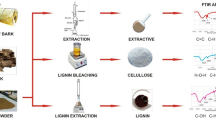Abstract
Scots pine battens were heat-treated at 100–240º C under saturated steam. Cross-sections of heat-treated battens were analysed using ATR and reflection FTIR microscopies. A typical absorption band of fats and waxes at 1740 cm-1 was detected on the sapwood edges in the temperature range of 100–160º C, indicating that fats and waxes moved along the axial parenchyma cells to the surface of the sapwood during the heat treatment. At the elevated temperatures (above 180° C) fats and waxes disappeared from the sapwood surface and were no longer detected with FTIR spectroscopy. Resin acids were detected at temperatures between 100 and 180º C in the middle of the battens. IR spectra of these spots showed a characteristic absorption band of resin acids at 1697 cm-1. At 200º C resin acids were not detected in the middle of the battens; however, resin acids were detected at distances of 500 and 600 mm from the midpoint of the battens and on the edges of battens. At temperatures above 200° C, resin acids had disappeared from the wood.






Similar content being viewed by others
References
Assarson A, Åkerlund G (1966) Studies on wood resin, especially the change in chemical composition during seasoning of the wood. Svensk Papperstidn 16:517–525
Back E (1991) Oxidative activation of wood surfaces for glue bonding. Forest Prod J 41:30–36
Back E (2000) The locations and morphology of resin components in the wood. In: Back EL, Allen LA (eds) Pitch control, wood resin and deresination, 1st ed., TAPPI, Atlanta, GA, pp 1–28
Fengel D, Wegener G (1989) Wood chemistry, ultrastructure, reactions. De Gruyter, New York
Forsskåhl I, Olkkonen C and Tylli H (1997) Uusien massanvalmistusmenetelmien vaikutus uuteaineisiin. PSC Communications Espoo: KCL 104:40–42 (in Finnish)
Hemingway R (1969) Thermal instability of fats relative to surface wettability of yellow birchwood. TAPPI J 52(11): 2149–2155
Holmbom B, Eckerman C (1983) Tall oil constituents in kraft pulping-effect of pulping temperature. TAPPI J 66(4):108–109
Holmgren A, Bergström B, Ericsson A and Gref R (1999) Detection of pinosylvins of Scots pine using Fourier transform Raman and infrared spectroscopy. J Wood Chem Technol 19:139–150
Ralston A (1948) Fatty acids and their derivates. Wiley, New York
Robert P, Safar M, Bertrand D, Defaux M and Genot C (1944) Characterization of edible oils, butters and margarines by Fourier transform infrared spectroscopy with attenuated total reflectance. J Am Oil Chem Soc 71(4): 371–377
Viitaniemi P, Jämsä S (1994) Modification of wood with heat treatment. VTT Research Report Publications 814, Espoo, Finland
Viitaniemi P, Jämsä S, Ek P and Viitanen H (1994) Method for improving biodegradation resistance and dimensional stability of cellulosic products. US Patent 5,678,324, 24 November, 1994
Author information
Authors and Affiliations
Corresponding author
Rights and permissions
About this article
Cite this article
Nuopponen, M., Vuorinen, T., Jämsä, S. et al. The effects of a heat treatment on the behaviour of extractives in softwood studied by FTIR spectroscopic methods. Wood Sci Technol 37, 109–115 (2003). https://doi.org/10.1007/s00226-003-0178-4
Received:
Published:
Issue Date:
DOI: https://doi.org/10.1007/s00226-003-0178-4




